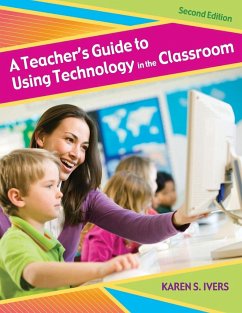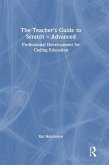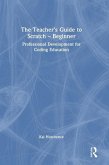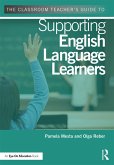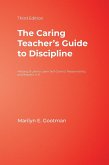Karen Ivers
A Teacher's Guide to Using Technology in the Classroom
Karen Ivers
A Teacher's Guide to Using Technology in the Classroom
- Broschiertes Buch
- Merkliste
- Auf die Merkliste
- Bewerten Bewerten
- Teilen
- Produkt teilen
- Produkterinnerung
- Produkterinnerung
Over 60% of this updated book is all new material focusing on the rapidly changing world of technology and its use in the classroom. Over 60 percent of this updated book is all new material focusing on the rapidly changing world of technology and its use in the classroom. Featuring updated weblinks, resources, research, and software reviews throughout, this title introduces podcasting, blogs, and course management systems as they relate to teacher tools and instruction and addresses pedagogical and management issues as they relate to one-to-one laptop environments. An all new chapter, Managing…mehr
Andere Kunden interessierten sich auch für
![The Teacher's Guide to Scratch - Advanced The Teacher's Guide to Scratch - Advanced]() Kai HutchenceThe Teacher's Guide to Scratch - Advanced187,99 €
Kai HutchenceThe Teacher's Guide to Scratch - Advanced187,99 €![The Teacher's Guide to Scratch - Beginner The Teacher's Guide to Scratch - Beginner]() Kai HutchenceThe Teacher's Guide to Scratch - Beginner184,99 €
Kai HutchenceThe Teacher's Guide to Scratch - Beginner184,99 €![The Classroom Teacher's Guide to Supporting English Language Learners The Classroom Teacher's Guide to Supporting English Language Learners]() Pamela MestaThe Classroom Teacher's Guide to Supporting English Language Learners33,99 €
Pamela MestaThe Classroom Teacher's Guide to Supporting English Language Learners33,99 €![The Teacher's Guide to Scratch - Intermediate The Teacher's Guide to Scratch - Intermediate]() Kai HutchenceThe Teacher's Guide to Scratch - Intermediate184,99 €
Kai HutchenceThe Teacher's Guide to Scratch - Intermediate184,99 €![The Classroom Teacher's Guide to Supporting English Language Learners The Classroom Teacher's Guide to Supporting English Language Learners]() Pamela MestaThe Classroom Teacher's Guide to Supporting English Language Learners107,99 €
Pamela MestaThe Classroom Teacher's Guide to Supporting English Language Learners107,99 €![The Writing Workshop Teacher's Guide to Multimodal Composition (6-12) The Writing Workshop Teacher's Guide to Multimodal Composition (6-12)]() Angela StockmanThe Writing Workshop Teacher's Guide to Multimodal Composition (6-12)166,99 €
Angela StockmanThe Writing Workshop Teacher's Guide to Multimodal Composition (6-12)166,99 €![The Caring Teacher's Guide to Discipline The Caring Teacher's Guide to Discipline]() Marilyn E. GootmanThe Caring Teacher's Guide to Discipline75,99 €
Marilyn E. GootmanThe Caring Teacher's Guide to Discipline75,99 €-
-
-
Over 60% of this updated book is all new material focusing on the rapidly changing world of technology and its use in the classroom. Over 60 percent of this updated book is all new material focusing on the rapidly changing world of technology and its use in the classroom. Featuring updated weblinks, resources, research, and software reviews throughout, this title introduces podcasting, blogs, and course management systems as they relate to teacher tools and instruction and addresses pedagogical and management issues as they relate to one-to-one laptop environments. An all new chapter, Managing and Assessing Computer Use Outside of the Classroom placed after Managing and Assessing Computer Use Inside of the Classroom focuses on content delivery and management over the Internet, with greater focus on podcasts, blogs, course management systems, and other content development tools for online learning and research related to online learning; tips and recommendations. The author has incorporated feedback from faculty and reviews of the previous edition in this revision. Grades K-12.
Produktdetails
- Produktdetails
- Verlag: Libraries Unlimited
- Seitenzahl: 192
- Erscheinungstermin: 28. Februar 2009
- Englisch
- Abmessung: 280mm x 216mm x 11mm
- Gewicht: 499g
- ISBN-13: 9781591585565
- ISBN-10: 1591585562
- Artikelnr.: 25610981
- Herstellerkennzeichnung
- Libri GmbH
- Europaallee 1
- 36244 Bad Hersfeld
- gpsr@libri.de
- Verlag: Libraries Unlimited
- Seitenzahl: 192
- Erscheinungstermin: 28. Februar 2009
- Englisch
- Abmessung: 280mm x 216mm x 11mm
- Gewicht: 499g
- ISBN-13: 9781591585565
- ISBN-10: 1591585562
- Artikelnr.: 25610981
- Herstellerkennzeichnung
- Libri GmbH
- Europaallee 1
- 36244 Bad Hersfeld
- gpsr@libri.de
¿ Karen Ivers (Author) taught elementary school before becoming a professor of teacher education. Karen loves finding creative and engaging ways to help students learn new concepts, especially in mathematics. She has written several books and appreciates Hope's ability to bring her characters to life! ¿ After retiring from the legal industry, Hope Richardson Fahey (Illustrator) returned to her love of illustrating. Hope has illustrated several children's books, including: Why is the Penguin Wearing Glasses, Laurel and Her House of Coral, Three Weeks in Women's Shoes, Pelly the Pitching Pelican, Pelly and the Plutonians, and Henry the Hessian. Intrigued by the concept of Karen's book and its focus on teaching, Hope's illustrations help to convey the warmth and emotions tied to the endearing story of how friendship and support can overcome adversity.
Preface
Chapter 1: Teachers and Technology
A Scenario
Introduction
Technology Standards for Teachers
National Educational Technology Standards for Teachers
State Technology Standards for Teachers
Computers 101
Computer Basics
System Recommendations
Secondary Storage Devices
Printers and Other Peripherals
Learning More About Computers
Computer Support
Getting to Know Your Technology Resource Teacher
Roles and Responsibilities
Resource Assistance
Technology Tips and Tricks
Accessing Special Characters
Taking a Picture of the Computer Screen
Other Tips and Tricks
Professional Development Opportunities
Summary
Activities
References
Blackline Masters
Chapter 2: Teacher Tools
A Scenario
Introduction
Productivity Tools
Instructional and Creative Tasks
Assessment
Record Keeping
Internet Resources for Teachers
Productivity and Management Tasks
Lesson Plans
Digital Discussions
E-mail
Listservs
Usenet Newsgroups
Discussion Forums
Blogs
Wiki
Chat
Additional Resources
Summary
Activities
Blackline Master
Chapter 3: Meeting the Needs of All Students
A Scenario
Introduction
Promoting Twenty-first-Century Learning Environments
Multiple Intelligences
Constructivism
Cooperative Learning
Technology and Special-Needs Students
English-Language Learners
Assistive Technologies
Software
Input Devices
Output Devices
Gifted Learners
Summary
Activities
Resources
References
Chapter 4: Prerequisites to Using Computers in the Classroom
A Scenario
Introduction
Technology Standards for Students
National Education Technology Standards (NETS)
State Technology Standards
Local Technology Standards
Computer Policies and Issues
Acceptable Use Policies
Technology Use Plan
Gender and Equity Concerns
Gender Issues
Equity Concerns
Ethics, Privacy, and Safety Issues
Ethics
Privacy and Safety Issues
Summary
Activities
References
Chapter 5: Evaluating Instructional Resources: Software
A Scenario
Introduction
Evaluating Software for Students
Software Categories
Applications
Tutorials
Drill and Practice
Simulations
Instructional Games
Problem Solving
Discovery, Reference, and Other Learning Tools
Evaluation Criteria
Instructional Objectives and Assessment
Appropriateness
Layout and Functionality
Management and Support Features
Evaluation Resources
Summary
Activities
Blackline Masters
Chapter 6: Evaluating Instructional Resources: The Internet
A Scenario
Introduction
Resources for Students
Web 2.0 Tools
Blogs
Wiki
Social Networking Sites
Social Bookmarking Sites
Photo and Video Sharing
Podcasts
Virtual Worlds
Interactive Programs
Online Experts
Web Sites for Children
Research Activities
Basic Research
WebQuests
Advanced Research
Search Engines
Search Strategies
Original Research
E-mail
Videoconferencing
Classroom Web Pages
Evaluation Criteria
Intent
Domain Name
Reason
Target Audience
Layout
Content
Authority
Currency
Bias
Verification of Information
Additional Tips
Issues to Consider
Troubleshooting Tips for the Internet
Summary
Activities
Reference
Blackline Masters
Chapter 7: Managing and Assessing Computer Use in the Classroom
A Scenario
Introduction
When to Use Computers
Objectives and Learner Outcomes
Assessing Resources
Computer Labs Versus Computers in the Classroom
Software and Peripherals
Prerequisite Skills
Monitoring and Assessing Students' Work
Planning and Managing Computer-Based Lessons
Grouping Strategies
Cooperative Learning Techniques
Group Size
One-to-One Laptop Classrooms
Designing a Classroom Computer Schedule
Lesson Ideas and Examples
Planning and Managing Multimedia Projects
Additional Tips for Integrating Computers Throughout the Curriculum
Monitoring and Assessing Students' Work
Ongoing Assessment
Rubrics
Summary
Activities
Resources
References
Blackline Masters
Chapter 8: Managing and Assessing Online Computing Environments
A Scenario
Introduction
Distance Education: Then and Now
Five Generations of Distance Learning
Standards for Delivering Instruction over the Internet
Virtual Environments for Learning
Course Management Systems
Additional Support for Delivering Online Instruction
Resources for Developing Course Content
Planning and Managing Online Learning
Elements of Online Environments That Support Student Learning
Layout and Design of an Online Learning Environment
Organization, Structure, Delivery, and Sharing of Content
Skills of the Teacher
Requirements, Expectations, and Recommendations
Prior Experience with Computers
Peer Interaction
Teacher/Student Interaction
Institutional Support
Monitoring and Assessing Students' Work in Online Learning Environments
Rubrics for Online Participation
Multiple Assessment Measures
Helpful Tips and Tricks
Summary
Activities
References
Glossary
Index
Chapter 1: Teachers and Technology
A Scenario
Introduction
Technology Standards for Teachers
National Educational Technology Standards for Teachers
State Technology Standards for Teachers
Computers 101
Computer Basics
System Recommendations
Secondary Storage Devices
Printers and Other Peripherals
Learning More About Computers
Computer Support
Getting to Know Your Technology Resource Teacher
Roles and Responsibilities
Resource Assistance
Technology Tips and Tricks
Accessing Special Characters
Taking a Picture of the Computer Screen
Other Tips and Tricks
Professional Development Opportunities
Summary
Activities
References
Blackline Masters
Chapter 2: Teacher Tools
A Scenario
Introduction
Productivity Tools
Instructional and Creative Tasks
Assessment
Record Keeping
Internet Resources for Teachers
Productivity and Management Tasks
Lesson Plans
Digital Discussions
Listservs
Usenet Newsgroups
Discussion Forums
Blogs
Wiki
Chat
Additional Resources
Summary
Activities
Blackline Master
Chapter 3: Meeting the Needs of All Students
A Scenario
Introduction
Promoting Twenty-first-Century Learning Environments
Multiple Intelligences
Constructivism
Cooperative Learning
Technology and Special-Needs Students
English-Language Learners
Assistive Technologies
Software
Input Devices
Output Devices
Gifted Learners
Summary
Activities
Resources
References
Chapter 4: Prerequisites to Using Computers in the Classroom
A Scenario
Introduction
Technology Standards for Students
National Education Technology Standards (NETS)
State Technology Standards
Local Technology Standards
Computer Policies and Issues
Acceptable Use Policies
Technology Use Plan
Gender and Equity Concerns
Gender Issues
Equity Concerns
Ethics, Privacy, and Safety Issues
Ethics
Privacy and Safety Issues
Summary
Activities
References
Chapter 5: Evaluating Instructional Resources: Software
A Scenario
Introduction
Evaluating Software for Students
Software Categories
Applications
Tutorials
Drill and Practice
Simulations
Instructional Games
Problem Solving
Discovery, Reference, and Other Learning Tools
Evaluation Criteria
Instructional Objectives and Assessment
Appropriateness
Layout and Functionality
Management and Support Features
Evaluation Resources
Summary
Activities
Blackline Masters
Chapter 6: Evaluating Instructional Resources: The Internet
A Scenario
Introduction
Resources for Students
Web 2.0 Tools
Blogs
Wiki
Social Networking Sites
Social Bookmarking Sites
Photo and Video Sharing
Podcasts
Virtual Worlds
Interactive Programs
Online Experts
Web Sites for Children
Research Activities
Basic Research
WebQuests
Advanced Research
Search Engines
Search Strategies
Original Research
Videoconferencing
Classroom Web Pages
Evaluation Criteria
Intent
Domain Name
Reason
Target Audience
Layout
Content
Authority
Currency
Bias
Verification of Information
Additional Tips
Issues to Consider
Troubleshooting Tips for the Internet
Summary
Activities
Reference
Blackline Masters
Chapter 7: Managing and Assessing Computer Use in the Classroom
A Scenario
Introduction
When to Use Computers
Objectives and Learner Outcomes
Assessing Resources
Computer Labs Versus Computers in the Classroom
Software and Peripherals
Prerequisite Skills
Monitoring and Assessing Students' Work
Planning and Managing Computer-Based Lessons
Grouping Strategies
Cooperative Learning Techniques
Group Size
One-to-One Laptop Classrooms
Designing a Classroom Computer Schedule
Lesson Ideas and Examples
Planning and Managing Multimedia Projects
Additional Tips for Integrating Computers Throughout the Curriculum
Monitoring and Assessing Students' Work
Ongoing Assessment
Rubrics
Summary
Activities
Resources
References
Blackline Masters
Chapter 8: Managing and Assessing Online Computing Environments
A Scenario
Introduction
Distance Education: Then and Now
Five Generations of Distance Learning
Standards for Delivering Instruction over the Internet
Virtual Environments for Learning
Course Management Systems
Additional Support for Delivering Online Instruction
Resources for Developing Course Content
Planning and Managing Online Learning
Elements of Online Environments That Support Student Learning
Layout and Design of an Online Learning Environment
Organization, Structure, Delivery, and Sharing of Content
Skills of the Teacher
Requirements, Expectations, and Recommendations
Prior Experience with Computers
Peer Interaction
Teacher/Student Interaction
Institutional Support
Monitoring and Assessing Students' Work in Online Learning Environments
Rubrics for Online Participation
Multiple Assessment Measures
Helpful Tips and Tricks
Summary
Activities
References
Glossary
Index
Preface
Chapter 1: Teachers and Technology
A Scenario
Introduction
Technology Standards for Teachers
National Educational Technology Standards for Teachers
State Technology Standards for Teachers
Computers 101
Computer Basics
System Recommendations
Secondary Storage Devices
Printers and Other Peripherals
Learning More About Computers
Computer Support
Getting to Know Your Technology Resource Teacher
Roles and Responsibilities
Resource Assistance
Technology Tips and Tricks
Accessing Special Characters
Taking a Picture of the Computer Screen
Other Tips and Tricks
Professional Development Opportunities
Summary
Activities
References
Blackline Masters
Chapter 2: Teacher Tools
A Scenario
Introduction
Productivity Tools
Instructional and Creative Tasks
Assessment
Record Keeping
Internet Resources for Teachers
Productivity and Management Tasks
Lesson Plans
Digital Discussions
E-mail
Listservs
Usenet Newsgroups
Discussion Forums
Blogs
Wiki
Chat
Additional Resources
Summary
Activities
Blackline Master
Chapter 3: Meeting the Needs of All Students
A Scenario
Introduction
Promoting Twenty-first-Century Learning Environments
Multiple Intelligences
Constructivism
Cooperative Learning
Technology and Special-Needs Students
English-Language Learners
Assistive Technologies
Software
Input Devices
Output Devices
Gifted Learners
Summary
Activities
Resources
References
Chapter 4: Prerequisites to Using Computers in the Classroom
A Scenario
Introduction
Technology Standards for Students
National Education Technology Standards (NETS)
State Technology Standards
Local Technology Standards
Computer Policies and Issues
Acceptable Use Policies
Technology Use Plan
Gender and Equity Concerns
Gender Issues
Equity Concerns
Ethics, Privacy, and Safety Issues
Ethics
Privacy and Safety Issues
Summary
Activities
References
Chapter 5: Evaluating Instructional Resources: Software
A Scenario
Introduction
Evaluating Software for Students
Software Categories
Applications
Tutorials
Drill and Practice
Simulations
Instructional Games
Problem Solving
Discovery, Reference, and Other Learning Tools
Evaluation Criteria
Instructional Objectives and Assessment
Appropriateness
Layout and Functionality
Management and Support Features
Evaluation Resources
Summary
Activities
Blackline Masters
Chapter 6: Evaluating Instructional Resources: The Internet
A Scenario
Introduction
Resources for Students
Web 2.0 Tools
Blogs
Wiki
Social Networking Sites
Social Bookmarking Sites
Photo and Video Sharing
Podcasts
Virtual Worlds
Interactive Programs
Online Experts
Web Sites for Children
Research Activities
Basic Research
WebQuests
Advanced Research
Search Engines
Search Strategies
Original Research
E-mail
Videoconferencing
Classroom Web Pages
Evaluation Criteria
Intent
Domain Name
Reason
Target Audience
Layout
Content
Authority
Currency
Bias
Verification of Information
Additional Tips
Issues to Consider
Troubleshooting Tips for the Internet
Summary
Activities
Reference
Blackline Masters
Chapter 7: Managing and Assessing Computer Use in the Classroom
A Scenario
Introduction
When to Use Computers
Objectives and Learner Outcomes
Assessing Resources
Computer Labs Versus Computers in the Classroom
Software and Peripherals
Prerequisite Skills
Monitoring and Assessing Students' Work
Planning and Managing Computer-Based Lessons
Grouping Strategies
Cooperative Learning Techniques
Group Size
One-to-One Laptop Classrooms
Designing a Classroom Computer Schedule
Lesson Ideas and Examples
Planning and Managing Multimedia Projects
Additional Tips for Integrating Computers Throughout the Curriculum
Monitoring and Assessing Students' Work
Ongoing Assessment
Rubrics
Summary
Activities
Resources
References
Blackline Masters
Chapter 8: Managing and Assessing Online Computing Environments
A Scenario
Introduction
Distance Education: Then and Now
Five Generations of Distance Learning
Standards for Delivering Instruction over the Internet
Virtual Environments for Learning
Course Management Systems
Additional Support for Delivering Online Instruction
Resources for Developing Course Content
Planning and Managing Online Learning
Elements of Online Environments That Support Student Learning
Layout and Design of an Online Learning Environment
Organization, Structure, Delivery, and Sharing of Content
Skills of the Teacher
Requirements, Expectations, and Recommendations
Prior Experience with Computers
Peer Interaction
Teacher/Student Interaction
Institutional Support
Monitoring and Assessing Students' Work in Online Learning Environments
Rubrics for Online Participation
Multiple Assessment Measures
Helpful Tips and Tricks
Summary
Activities
References
Glossary
Index
Chapter 1: Teachers and Technology
A Scenario
Introduction
Technology Standards for Teachers
National Educational Technology Standards for Teachers
State Technology Standards for Teachers
Computers 101
Computer Basics
System Recommendations
Secondary Storage Devices
Printers and Other Peripherals
Learning More About Computers
Computer Support
Getting to Know Your Technology Resource Teacher
Roles and Responsibilities
Resource Assistance
Technology Tips and Tricks
Accessing Special Characters
Taking a Picture of the Computer Screen
Other Tips and Tricks
Professional Development Opportunities
Summary
Activities
References
Blackline Masters
Chapter 2: Teacher Tools
A Scenario
Introduction
Productivity Tools
Instructional and Creative Tasks
Assessment
Record Keeping
Internet Resources for Teachers
Productivity and Management Tasks
Lesson Plans
Digital Discussions
Listservs
Usenet Newsgroups
Discussion Forums
Blogs
Wiki
Chat
Additional Resources
Summary
Activities
Blackline Master
Chapter 3: Meeting the Needs of All Students
A Scenario
Introduction
Promoting Twenty-first-Century Learning Environments
Multiple Intelligences
Constructivism
Cooperative Learning
Technology and Special-Needs Students
English-Language Learners
Assistive Technologies
Software
Input Devices
Output Devices
Gifted Learners
Summary
Activities
Resources
References
Chapter 4: Prerequisites to Using Computers in the Classroom
A Scenario
Introduction
Technology Standards for Students
National Education Technology Standards (NETS)
State Technology Standards
Local Technology Standards
Computer Policies and Issues
Acceptable Use Policies
Technology Use Plan
Gender and Equity Concerns
Gender Issues
Equity Concerns
Ethics, Privacy, and Safety Issues
Ethics
Privacy and Safety Issues
Summary
Activities
References
Chapter 5: Evaluating Instructional Resources: Software
A Scenario
Introduction
Evaluating Software for Students
Software Categories
Applications
Tutorials
Drill and Practice
Simulations
Instructional Games
Problem Solving
Discovery, Reference, and Other Learning Tools
Evaluation Criteria
Instructional Objectives and Assessment
Appropriateness
Layout and Functionality
Management and Support Features
Evaluation Resources
Summary
Activities
Blackline Masters
Chapter 6: Evaluating Instructional Resources: The Internet
A Scenario
Introduction
Resources for Students
Web 2.0 Tools
Blogs
Wiki
Social Networking Sites
Social Bookmarking Sites
Photo and Video Sharing
Podcasts
Virtual Worlds
Interactive Programs
Online Experts
Web Sites for Children
Research Activities
Basic Research
WebQuests
Advanced Research
Search Engines
Search Strategies
Original Research
Videoconferencing
Classroom Web Pages
Evaluation Criteria
Intent
Domain Name
Reason
Target Audience
Layout
Content
Authority
Currency
Bias
Verification of Information
Additional Tips
Issues to Consider
Troubleshooting Tips for the Internet
Summary
Activities
Reference
Blackline Masters
Chapter 7: Managing and Assessing Computer Use in the Classroom
A Scenario
Introduction
When to Use Computers
Objectives and Learner Outcomes
Assessing Resources
Computer Labs Versus Computers in the Classroom
Software and Peripherals
Prerequisite Skills
Monitoring and Assessing Students' Work
Planning and Managing Computer-Based Lessons
Grouping Strategies
Cooperative Learning Techniques
Group Size
One-to-One Laptop Classrooms
Designing a Classroom Computer Schedule
Lesson Ideas and Examples
Planning and Managing Multimedia Projects
Additional Tips for Integrating Computers Throughout the Curriculum
Monitoring and Assessing Students' Work
Ongoing Assessment
Rubrics
Summary
Activities
Resources
References
Blackline Masters
Chapter 8: Managing and Assessing Online Computing Environments
A Scenario
Introduction
Distance Education: Then and Now
Five Generations of Distance Learning
Standards for Delivering Instruction over the Internet
Virtual Environments for Learning
Course Management Systems
Additional Support for Delivering Online Instruction
Resources for Developing Course Content
Planning and Managing Online Learning
Elements of Online Environments That Support Student Learning
Layout and Design of an Online Learning Environment
Organization, Structure, Delivery, and Sharing of Content
Skills of the Teacher
Requirements, Expectations, and Recommendations
Prior Experience with Computers
Peer Interaction
Teacher/Student Interaction
Institutional Support
Monitoring and Assessing Students' Work in Online Learning Environments
Rubrics for Online Participation
Multiple Assessment Measures
Helpful Tips and Tricks
Summary
Activities
References
Glossary
Index

